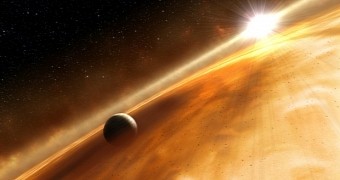It might be that planets whose anatomy is similar to Earth's and that orbit rather petite stars are perfectly life-friendly, a team of researchers with the University of Washington argue in a recent paper in the journal Astrobiology.
The team, led by astronomer Peter Driscoll, carried out a series of simulations and found that it is possible for habitable planets to form even in the proximity of stars 10 times smaller than our Sun.
It's magnetic fields that hold the key to habitability
Writing in the journal Astrobiology, the University of Washington research team explains that, when it comes to making a planet habitable, magnetic fields can only come in handy.
For starters, a magnetic field, which originates from a planet's core, protects a potential atmosphere by deflecting the charged particles that make up stellar wind. Then, it also protects potential lifeforms by shielding them from harmful radiation.
For quite some time, the general view was that the chances that planets orbiting close to small stars could develop magnetic fields and become habitable were slim to none.
It was assumed that, to receive enough heat to host liquid water on their surface, such orbs would also have to sit very close to their parent star, which would in turn expose them to a mindbogglingly strong gravitational pull and lock them in place.
Thus, it was said that Earth-like planets close to small stars would forever show just one side to their host. Then, the same gravitational pull locking them in place would generate tidal heating and give rise to intense volcanic activity on their surface.
“A planet so close to its star is subject to the star’s powerful gravitational pull, which could cause it to become tidally locked, with the same side forever facing its host star, as the Moon is with the Earth.”
“That same gravitational tug from the star also creates tidally generated heat inside the planet, or tidal heating. Tidal heating is responsible for driving the most volcanically active body in our solar system, Jupiter’s moon Io,” specialists explain.
These particularities were thought to make it impossible for Earth-like planets orbiting close to small stars to develop magnetic fields and so become habitable.
Except the University of Washington team disagrees
Study leader Peter Driscoll and fellow researchers argue that, contrary to these assumptions, their simulations showed that it is perfectly possible for such planets to form magnetic fields.
In fact, it looks like tidal heating can actually help them do so by dissipating heat and cooling the core. What this means is there is no reason planets close to small stars couldn't be life-friendly, the scientists explain.
“I was excited to see that tidal heating can actually save a planet in the sense that it allows cooling of the core. That’s the dominant way to form magnetic fields,” said specialist Peter Driscoll.
Interestingly, low-mass stars like the ones this study focused on are some of the most common in the universe. If it's true that planets orbiting close to them can have a magnetic field and be habitable, perhaps this is where we should look for alien life.

 14 DAY TRIAL //
14 DAY TRIAL //